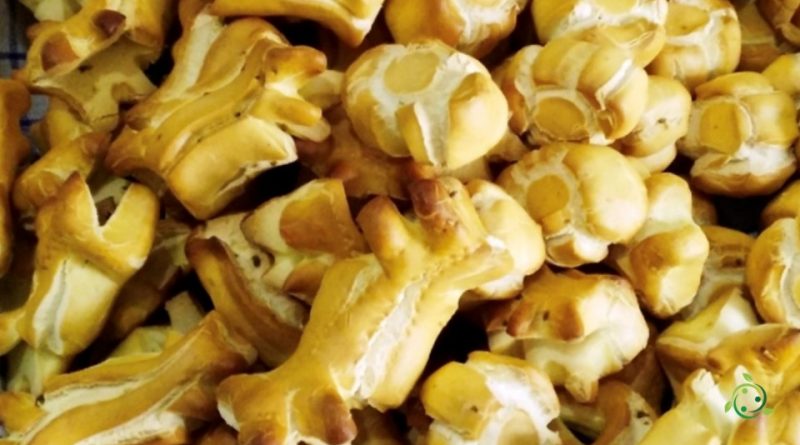Boiled biscuits
Boiled biscuits
Boiled biscuits, or affuca parrini, are typical biscuits of Ragusa cuisine, officially recognized and included in the list of traditional Italian agri-food products (P.A.T.) of the then Ministry of Agricultural, Food and Forestry Policies (Mipaaf).
Origins and History –
Boiled biscuits, known in Sicilian as viscotta scaurati, are a culinary specialty typical of south-western Sicily and in particular of the province of Ragusa.
Their origin is linked to the culinary traditions of Sicily and the simplicity of the ingredients used.
The history of boiled biscuits dates back to ancient times, when resources were limited and people tried to prepare foods that could be stored for a long time without spoiling. These biscuits were often baked during times of famine or when fresh ingredients were scarce.
Geographic area –
Boiled biscuits are a typical specialty of south-western Sicily. The specific territory is that which falls within the Municipalities of the Iblea Area and the production period is the Easter period.
These biscuits are available in Ragusa bakeries mainly during the Easter period.
Raw material –
The basic ingredients for Ragusa boiled biscuits include flour, sugar, eggs, and a leavening agent such as brewer’s yeast or baking soda.
In detail, the main ingredients, almost always present, are:
– egg;
– sugar;
– lard;
– Mallorca flour;
– yeast;
– semolina;
– anise seeds;
– lemons.
Description –
Boiled biscuits are biscuits peculiar to Ragusa and Iblei, lightly flavored with anise and cooked in the oven only after an initial boiling phase.
For this reason they have the consistency and appearance of small loaves of bread, with a fairly homogeneous color and with different shapes, from those of a small rosette of bread to more elongated and differentiated shapes.
Production Mode –
To prepare boiled biscuits, a dough must be prepared and subsequently formed into small balls and boiled in water for a few minutes, giving them a unique consistency. Once boiled, the biscuits can be left to dry or baked further in the oven to obtain a crispier surface.
The preparation begins by placing the re-milled semolina flour and the soft wheat flour in a bowl, adding the sugar.
The lard and eggs should also be added to this mixture, working everything together.
At this point, add the juice of half a lemon and a drizzle of water, just the amount necessary to absorb all the flour, but the dough must be very compact.
Finally, the anise seeds are added.
We continue to work everything on a pastry board until the dough is smooth and homogeneous.
After which the dough is divided into 3-4 pieces, creating cords.
At this point, you can make small boiled biscuits (which are the crunchiest) by cutting many pieces, as if they were gnocchi.
Alternatively, you can make larger and more artistic biscuits, of different make and shape.
Once you have made the shapes, put plenty of water to boil in a pan.
When it comes to the boil, add a drizzle of oil and immerse the biscuits.
You must take care to cook the small ones for 3 minutes, the large ones for 5 minutes.
After this cooking, drain the biscuits on a slightly inclined wooden surface and then transfer them onto a cloth.
The biscuits should be left to dry completely for at least two hours, preferably overnight.
After this period, the boiled biscuits are cooked in a preheated ventilated oven at 200° for 12-15 minutes, or in any case until golden.
They are then removed from the oven and left to cool completely. At this point they are ready to be enjoyed or stored in an airtight container: they will keep for up to two weeks.
Some variations of the recipe involve replacing anise seeds with fennel seeds.
Furthermore, the biscuits can also be cooked in a static oven at 220° for 15-20 minutes.
The lard can be replaced with extra virgin olive oil but, in this case, the biscuits will be harder.
There are further variations, linked to family or pastry shop traditions, which add extra ingredients or make personal changes. However, the basis of the preparation remains rooted in Sicilian history and tradition.
Gastronomic use –
Boiled biscuits are often eaten with coffee or wine, and are enjoyed for their simplicity and traditional flavour. The tradition of preparing Ragusa boiled biscuits has been handed down from generation to generation, becoming an integral part of the local gastronomic culture.
Guido Bissanti
Sources
– National list of traditional agri-food products, of the Ministry of agricultural, food, forestry and tourism policies, pursuant to art. 12, paragraph 1, of law 12 December 2016, n. 238 and subsequent amendments.
– Wikipedia, the free encyclopedia.

